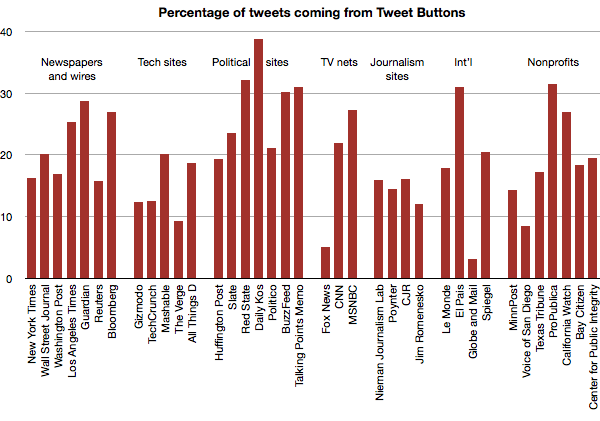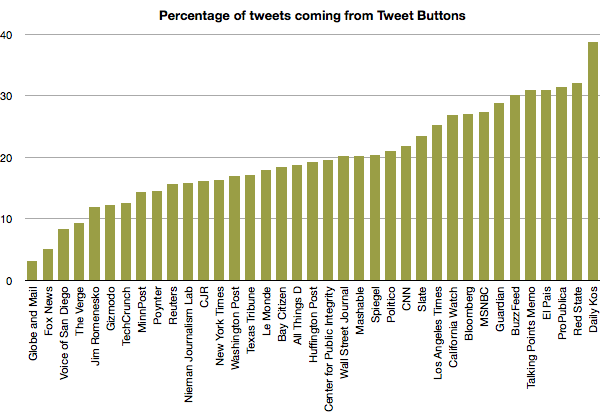 News sites today are pockmarked with sharing buttons, those little “tweet this” or “like that” rectangles attached to seemingly every story these days.
News sites today are pockmarked with sharing buttons, those little “tweet this” or “like that” rectangles attached to seemingly every story these days.
In some ways, it’s not as bad as it used to be, when there were more social networks making a plausible claim on people’s attention. (Digg that!) But even in a world that’s mostly shaken out to Facebook and Twitter — plus maybe Google+ if you’re generous, or LinkedIn if you write about business, or Pinterest if you’re about shopping or food, or…sigh. Well, even in a world that’s mostly shaken out to a few social networks, those buttons are still a less than appealing set of warts on the body hypertext.
That’s the argument advanced by designer Oliver Reichenstein in a blog post (“Sweep the Sleaze”) that got a lot of attention this week:
But do these buttons work? It’s hard to say. What we know for sure is that these magic buttons promote their own brands — and that they tend to make you look a little desperate. Not too desperate, just a little bit…
Don’t worry. These buttons will vanish. The previous wave of buttons for Delicious and Digg and Co. vanished, Facebook and Twitter and G+ might vanish or they might survive, but the buttons will vanish for sure. Or do you seriously think that in ten years we will still have those buttons on every page? No, right? Why, because you already know as a user that they’re not that great. So why not get rid of them now? Because “they’re not doing any harm”? Are you sure?
Not surprising, coming from a designer best known in the technology world for building a minimalist writing app.
But do those Like buttons and Tweet Buttons do any good? To get some data on that, we can thank Luigi Montanez of Upworthy, who posted a Ruby script that allows you to see, of the n most recent tweets containing a given URL string, how many of them were generated by a Tweet Button. (More detail here.) Luigi found that there’s substantial variation among different sites.
I downloaded the script and decided to start running it on a variety of news sites to see if I could suss out any patterns. This isn’t hard science, for reasons I’ll get into in a moment, but it’s interesting! Here are the results from 37 news sites, first divided up by type of news site. (I looked at the 1,000 most recent tweets for each, rather than Luigi’s 500.)

The Y axis is the percent of the 1,000 most recent tweets that Twitter says were generated by a Tweet Button. So, 16.3 percent of those tweets to nytimes.com (The New York Times) came from such a button, versus 20.2 percent for wsj.com (The Wall Street Journal).
Two broad observations:
— Tech sites seem to be less reliant on the Tweet Button, as a percentage — as one might expect from sites with a social media-savvy audience. Presumably readers of The Verge are comfortable copying and pasting a URL into Twitter on their own, or tweeting to Verge content by seeing someone else’s reference to it in their feed.
— Sites with a clear ideological profile — Daily Kos on the left (38.8 percent) and Red State on the right (32.1 percent), for instance — are among the heaviest beneficiaries of the Tweet Button. Could that be because their readers are explicitly looking to those sites for links to share on their networks, and the Tweet Button is an easy way to speed up that process? But Fox News seems to be an interesting exception to that observation — only 5.1 percent of its tweets came through the button, versus 27.3 percent for MSNBC.
Most other sites seems to fall into a broad middle, which makes sense. Here’s that same data, but this time ordered by percentage rather than grouped by type of outlet:

All right, let’s all visit Caveat Central — a place of particular interest to any journalism graduate student who’d like to tackle this in a more serious way and get a good AEJMC paper out of it:
— This is just a snapshot of 1,000 tweets’ worth of data, taken around 11:30 a.m. ET today. You’d need a much bigger data set to do any serious analysis. The numbers could be substantially different at a different time of day or day of week, for instance, or at different points in a story’s life cycle. You’d also need to get raw counts over time — “the 1,000 most recent tweets” might cover a span of 15 minutes for some sites and several days for another.
— This script doesn’t measure other Twitter app data — in other words, how many are using the Twitter iPhone app, how many are using news org-branded apps, how many are using TweetDeck, how many are using Twitter’s web interface? Lots of interesting data potential in there. It would also be interesting to correlate the results with each news org’s own Twitter presence; The New York Times’ 5.1 million Twitter followers no doubt make Tweet Button usage seem smaller in comparison. (It’s also worth noting that some sites may have something that looks like a Tweet Button that’s actually registered with Twitter under a different app name; those wouldn’t show up here.)
— Not all Twitter users are created equal, of course. How do the Tweet Button users compare to those using other means to tweet — particularly in the size of their Twitter followings? If Tweet Button users were numerous but had small followings, they might not be as valuable to news organizations as they’d seem at first glance.
— To do this justice, you’d also need to analyze placement of Tweet Buttons on sites. Audience composition isn’t the only reason Tweet Button behavior might change, of course; potentially much bigger is the placement of Tweet Buttons on each site. (Just below the headline? At story’s end? Both?)
But even this quick look would seem to support the idea that killing off Tweet Buttons would, for most news organizations, remove somewhere around 20 percent of their Twitter link mentions. Maybe more, if (as I’d guess, although with no data) that those Tweet Button users are often something like a Tweeter Zero — an originator that enables a story’s later spread through other means. (Here’s where a tool like the Times’ Cascade would be really useful.) Or maybe less, since some percentage of those Tweet Button users would still find other means to tweet without them. Here’s hoping some Ph.D. student runs with this.